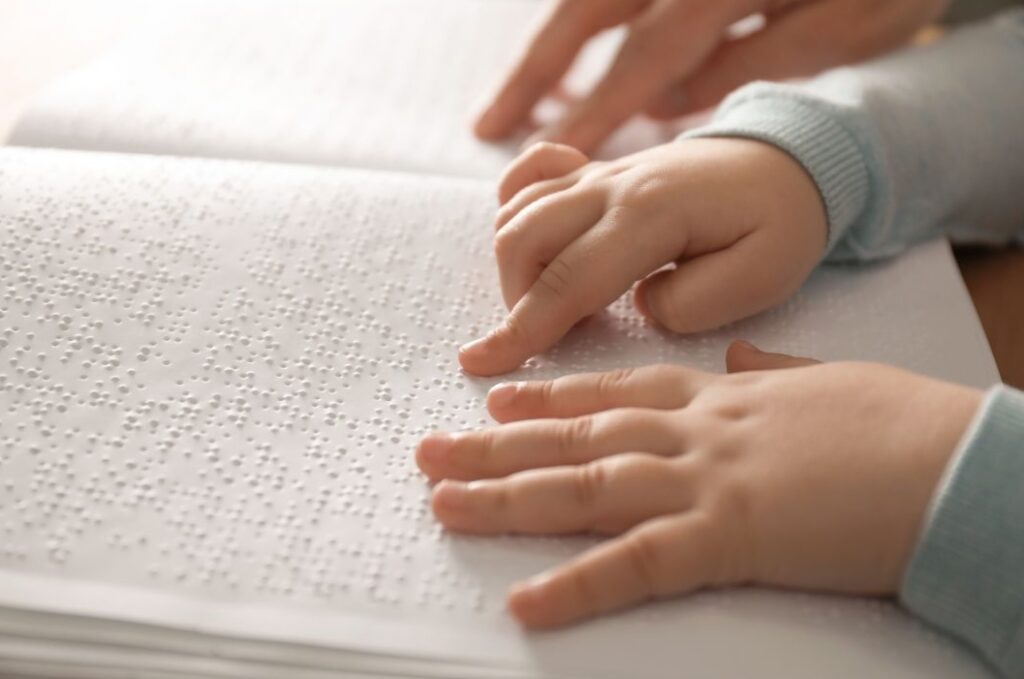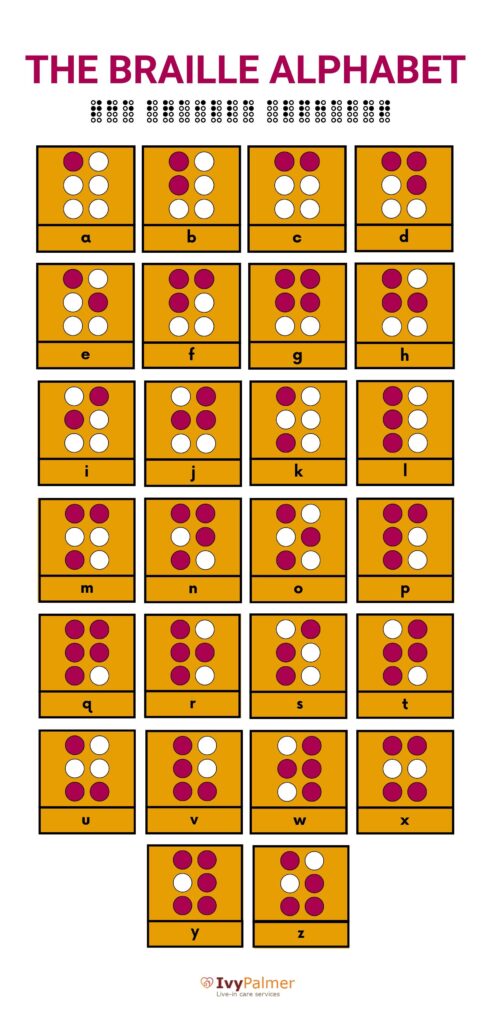World Braille Day, observed annually on January 4th, is a significant occasion to celebrate the profound impact of Louis Braille’s revolutionary coding system.
The importance of World Braille Day lies in its mission to raise awareness about the challenges faced by the blind and partially sighted, emphasising the role braille plays in fostering communication, education, and social inclusion.
If you are an unpaid carer, learning how to read braille can deepen your ability to support and connect with your loved one facing visual challenges. Equally, if you are a visual impairment carer, braille is necessary to ensure effective and specialised support.
Learning more about braille, its benefits, and its role in enhancing the quality of life for those with visual impairments can be a powerful step toward providing holistic care.
What is Braille?

Braille is a vital tool for fostering social inclusion and education, but what exactly is it?
Braille is a tactile representation of alphabetical and numerical symbols, employing a unique system of six dots to represent each letter and number.
Primarily designed for blind and partially sighted individuals, braille extends its utility beyond conventional language symbols to encompass musical, mathematical, and scientific notations.
When engaging with braille, individuals glide their fingertips over the embossed dots arranged in lines, decoding written content such as books and newspapers and everyday objects such as signs, packaging, and product labels.
Two variants of braille exist: uncontracted and contracted. The former meticulously spells out every word, ensuring a comprehensive reading experience, while the latter functions as a shorthand version, emphasising familiar words for increased efficiency.
Braille also empowers those who require it to write, offering a means of communication and self-expression.
In essence, braille plays a crucial role in a blind or partially sighted individual’s ability to access information, education, and social engagement.
The History of Braille

Louis Braille, the visionary inventor behind the tactile writing system, was born in 1809 in Coupvray, France.
Tragically, Louis lost his eyesight at the age of three due to a mishap with a stitching awl in his father’s workshop. Undeterred by this adversity, Braille’s inventive spirit flourished, leading him to devise the revolutionary braille system.
In 1824, after years of dedicated work, he completed the system.
This ingenious creation, now globally recognised, has become indispensable for the visually impaired.
Today, even iconic games like Monopoly and LEGO are available in braille versions.
To honour Louis Braille’s remarkable contribution, World Braille Day was established, celebrated annually on January 4th, coinciding with the inventor’s birthday.
Getting Started with Braille
If you want to learn braille, understand that it is not a language but a coding system that allows the representation of various languages and symbols.
So, what is the braille alphabet (UK)?
The braille code operates in different grades, with Grade 1 being the most fundamental.
In Grade 1, each letter is individually transcribed into a braille character. This unique character is formed within a braille cell, a structured arrangement of six dots organised into two columns and three rows.
The first column from top to bottom represents dots 1, 2, and 3, while the second column corresponds to dots 4, 5, and 6.
The combinations of raised and unraised dots within the braille cell provide a tactile representation for each letter, number, or symbol.

This system offers a systematic and accessible means for individuals with visual impairments to engage with written information. Understanding the intricacies of the braille code and its organisational structure is essential for those who rely on this system for reading and communication.
The Benefits of Learning Braille for Live-In Carers
If you care for a friend or relative who is blind or partially sighted, understanding and using braille can be a powerful tool to enhance communication and support their overall well-being.
But, what is braille in health and social care?
As a live-in carer, incorporating braille into your interactions contributes to an individual’s development of essential reading and writing skills – making information more accessible.
Braille in communication helps to improve their day-to-day activities and broadens their future opportunities.
Braille proves particularly beneficial when deciphering medical packaging, granting individuals with visual impairments the independence to manage their medications.
As a carer, taking individuals on outings, such as museum trips, becomes enriched as you assist in reading signs equipped with braille.
Engaging in shared reading and writing activities fosters a sense of connection, and your support is crucial in building their confidence.
Ultimately, introducing braille into their lives gives them the same access to written content as any sighted person, facilitating the development of their reading skills and contributing to a more inclusive and fulfilling life.
As a live-in carer who knows braille, you provide the most optimum support possible for a visually impaired individual.
Tips for Effective Braille Learning

Whether you want to learn braille for yourself or to assist an individual you care for, below are some tips to help you.
- Move fingers from left to right, mirroring sighted reading.
- Start with the fingertip of your index finger and progress to using multiple fingers over time.
- Remember that the sensitivity of your fingertips will quickly develop, making the task easier.
- Practise regularly to refine fine motor and hand skills.
- Integrate braille into practical activities like cooking, reading packaging, jars, and instructions.
- Make braille part of a routine when helping an individual with their personal care, reading instructions on items like shampoo and toothpaste.
- Master Grade 1 braille (uncontracted) before moving to contracted braille.
- Read and translate braille dots using both fingers and eyes for reinforcement.
- Utilise resources like the Royal National Institute of Blind People for advice and lessons.
- Join a local class to learn with a group, acknowledging that Grade 1 Braille may take around ten sessions.
- Recognise that everyone learns at different paces and supplement learning with a study guide.
Celebrating World Braille Day
So, how can you celebrate World Braille Day?
Celebrating World Braille Day involves several meaningful actions that raise awareness and positively impact the lives of the blind and partially sighted.
Spread Awareness
Begin by spreading awareness of the day, emphasising the significance of understanding and respecting the challenges faced by individuals with visual impairments.
Give to Charity
Consider donating to a blind charity, providing vital support for initiatives to improve the lives of those in need.
Learn Braille
Learning to use braille is a powerful way to participate actively in the celebration. By assisting individuals who rely on braille, you not only make a difference in their lives but also gain a deeper understanding of the importance of this tactile coding system.
Honour Louis Braille
In celebrating World Braille Day, you also pay homage to Louis Braille, the visionary creator of this invaluable system, acknowledging the transformative impact it has had on the lives of countless individuals around the world.
If you care for a loved one facing visual challenges, embracing braille becomes a gateway to enhanced communication, independence, and inclusion.
The support of a live-in carer can provide invaluable respite. With IP Live-in Care, a dedicated carer can deliver specialised assistance tailored to your loved one’s unique needs, offering relief by handling tasks and responsibilities. It ensures your loved one receives the care they deserve and allows you to take necessary breaks, fostering a balanced and sustainable caregiving arrangement.
So, find a live-in carer today to support you and your loved one.
